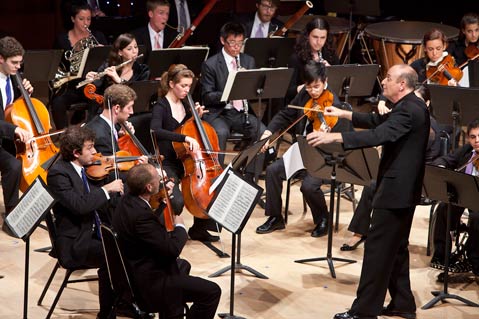Academy Chamber Players at Hahn Hall
The Music Academy Played Host to Three Impressive Performances on Saturday, June 30

Three works, radically divergent in period, spirit, and instrumentation, demonstrated the flexibility and range of the Music Academy Fellows, while giving audience members exercise in the elusive skill of shifting gears. Rhode Island Philharmonic Music Director and Shepherd School of Music Professor Larry Rachleff conducted this subset of Academy Fellows, following in the wake of his captivating Festival Orchestra performance at the Granada Theatre last week.
Chamber music favors an intimate space, a room that supports and amplifies small ensembles and soloists, which is why the Music Academy’s Hahn Hall is often regarded as Santa Barbara’s foremost venue for chamber music. While many patrons are used to hearing quartets and trios on that stage, the opening number, Mozart’s Overture to The Abduction from the Seraglio (1781), demonstrated that the room can handle an orchestra of 42 — as long as a few rear stage panels are replaced with acoustical draperies. From its gentle string beginnings to the bass drum and cymbal accents, the sound was comfortable and balanced. An ideal concert warm-up, this overture is written in alla turca style, an 18th-century European caricature of Ottoman military bands that employs a march beat, bass drum, cymbal, and triangle in the percussion section. Modern audiences still enjoy the exciting rhythm but not the exotic places these pieces once conjured.
Instead, the exotic came by way of Olivier Messiaen’s Couleurs de la cité céleste (1963). A work for piano, percussion, and winds, the Messiaen is a disjointed journey that is often cacophonous and atonal, an about-face from the classical sensibility of harmony and order. Maestro Rachleff made efforts to buffer the shock with preliminary remarks that explained Messiaen’s unusual psychic condition (synesthesia — he could see colors in sounds); diverse influences, including bird songs and Roman Catholic liturgy; and penchant for unusual instrumentation. He even gave us tips for listening, likening the experience to a kaleidoscope, or TV channel surfing. Once it began, a spread of percussion instruments arched across the stage: piano, chimes, herdbells, xylophone, marimba, xylorimba, and an array of gongs. Behind sat an equally impressive 10-piece brass section, while three clarinets huddled front and center. Couleurs is a flight of surprises in time, texture, and timbre: long tones and long rests (often colored by the decay of a percussion strike), great swaths of brass choir in complex chords, frantic eruptions of percussion in dazzling coordination and complexity, and peculiar overtones emerging from shrill clarinet atop trombone. It made for a rare experience that was enjoyed by both players and audience, as it is no small feat to assemble this peculiar instrumentation and musical finesse.
An ensemble of only 18 players finished the program with Aaron Copland’s Suite from Appalachian Spring (1944). Often performed by full symphony orchestra, this intimate arrangement more effectively conveys the tenderness and rural romance of the American pioneer. The eight short movements seem to survey everything from country two-step barn dancing to pensive meditations on human frailty and the loneliness of the wide-open spaces. Especially noteworthy were the solo woodwind parts by flutist Christy Kim. Look to July 26 and 28 and August 4 for more promising chamber music performances by the Music Academy Fellows



